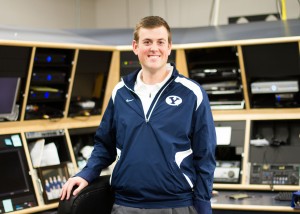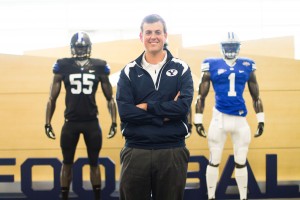Young athletes dream of one day making it to the big leagues and playing in front of thousands of fans, and for a select few, that dream actually becomes a reality.
BYU has won 10 NCAA titles and 296 conference championships; it has produced 75 Olympians and more than 1,000 All-Americans. All of these titles, championships and super athletes started well before these they reached college. Coaches constantly watch, observe and recognize young athletes as having serious potential. However, the science of recruiting is much more than just recognizing talent and watching game file — it is about relationships.
“The most important information to know is that it’s about relationships,” assistant women’s volleyball coach Heather Olmstead said. “You are recruiting people who have feelings and emotions.”

These relationships are not only essential for those doing the recruiting, but for the athlete prospects as well. This two-way relationship helps both parties come to the best solution. Athleticism is a major part of recruiting, but character and academics take up their fair share of the decision. Matching the personality of the team and the coach with the personality of the athlete is a key element to finding prospects.
“We look for character first when we look at an athlete,” BYU football’s director of player personnel Geoff Martzen said. “They have to have the character to make it in the program, then the athletics.”
The NCAA has rules and regulations for contacting athletes that are too young, but recruiters are aware and even watch athletes as young as 13. Finding young talent and building a relationship with coaches or those they are close to is essential for the success of the program.
“Recruiting is finding a fit to your program that you feel can help you win games,” University of Utah football assistant coach Morgan Scalley said.
The future of the program lies in the athletes that play the sports they love and the recruiters that can identify this talent. These student-athletes are found through camps, various online ranking services and personal contact through high school coaches. As the number of athletes coming to these camps and wanting to play sports at the next level increases, recruiters must be organized in order to keep track of them.
“Since there are thousands after thousands of kids who want to play football here at BYU, you have to really be organized and efficient,” Martzen said.
Director of player personnel is a fairly new position that is growing in popularity around the nation. A director of player personnel is mostly involved in identifying prospects and handing them off to coaches for evaluation. Martzen started this position at BYU three weeks ago and his hopes are that this division will become self-sufficient. The NCAA limits him from evaluating the prospects, but he does his part in making sure the coaches receive the best prospects for the football program.
“Recruiting consists of identifying, evaluating, marketing and customer service,” Martzen said.

Recruiting is not perfect, nor is it something that is taught. Many coaches are taught or trained just by watching film and watching players play. This science is based on the skills and abilities of the coaches recruiting.
At times, a coach can observe a player and know instantly that the athlete has something special, while other times it takes years until the individual matures and blooms. These decisions can be challenging, but can make all the difference for the program.
“This is not a perfect science,” BYU soccer associate head coach Chris Watkins said. “Sometimes it is pretty obvious right when you watch a kid play, other times it takes a while and you take a gamble.”
Some gambles pay off, like BYU linebacker Ziggy Ansah, while others don’t. Players can create amazing highlight videos, but a good recruiter will go beyond the video and watch multiple games over a long period of time to see how good these young athletes are.
“You learn as you go,” Scalley said. “You learn the science and learn if you are being fooled or not.”
Luckily, a recruiter is not on his own in these decisions. Coaches meet together and watch film and discuss the various prospects to decide who will make it and who won’t. The coaches evaluate academics and the character of the individuals to make sure they are getting the best student-athlete they can.
“Luckily, as a staff we talk together about the players, and we make a lot of decisions together,” Olmstead said. “It is important for us to meet and decide who will fit best in our program.”
Recruiting is behind the scenes and unnoticed by the hundred of thousands of sport spectators, but the impact of this responsibility can depend on the success or failure of a team. Many coaches take on this responsibility and drive their own recruiting, while new positions arise to lead the way of identifying prospects and evaluating them. This small position creates huge results. There is no Recruiting 101 class at BYU, but there could be as a new science becomes more and more important.




